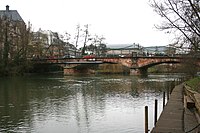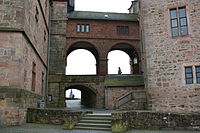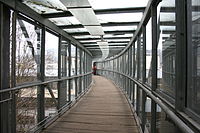Bridges in Marburg
Bridges in Marburg are bridges in the urban area of the regional center of Marburg in Central Hesse . Due to its narrow valley location - in the core city area west of the Marburg Ridge , east of the Lahn Mountains , with the Lahn in between - as well as the Main-Weser-Bahn and Bundesstraße 3 traffic arteries , Marburg is particularly dependent on bridge structures.
history


Since it was founded, Marburg has been on the right bank of the Lahn on the mountainside below the castle . On the other side of the Lahn there were no buildings other than the bridge suburb of Weidenhausen. A stone bridge had been in place to connect with this suburb since the 13th century. The next river crossing was the Nehbrücke in the south near Argenstein . Half a millennium later, a second stone bridge was built in the north of the city as a connection to Poststrasse to the north (Cölbe, Kassel), the Elisabeth Bridge . And after the expansion from Marburg beyond the medieval city walls, a third connection was established over the Lahn in 1892. The Schützenpfuhlbrücke was built to the south in 1892.
Stone bridges
The Weidenhausen Bridge was also called the City Bridge or Long Bridge in the Middle Ages. Exact dates of creation are not known. First reports date from the middle of the 13th century. Two disasters hit the bridge. On January 10, 1552, it collapsed due to flooding. 24 people were killed. In another severe winter flood on December 31, 1763, two pillars were torn away. These were replaced by a wooden structure. It was not until 1892 that the bridge, which still exists today, was built with four additional segment arches according to plans by the city architect Broeg.
In the north of Marburg a second stone bridge, the Elisabeth Bridge, was built in 1723 . The Poststrasse to Cölbe and Kassel ran over them . This bridge was renewed in 1867 with wide segment arches. About them Bahnhofstrasse led as connecting the city to the far outside scale Railway Station of the Main-Weser Railway , which was inaugurated on April 3, 1850th In the course of Bahnhofstrasse, two more stone bridges were built over the existing mill ditches at the same time and the entire street was raised one meter to prevent flooding from obstructing the connection to the station, as was often the case before. Since then, the Elisabeth Bridge has also been called the Bahnhofsbrücke .
A third crossing of the Lahn with a stone bridge was built in 1892 in the south of the city, the Schützenpfuhlbrücke . It connected the newly created southern district with Cappel .
Wooden bridges shortened the distances
After Marburg prospered after the annexation of Kurhessen by Prussia, districts emerged outside the city walls, but initially only on the right side of the Lahn. Around 1900 the citizens of Marburg also took possession of the other side of the Lahn step by step. First allotment gardens were created and excursion sites were created ( Spiegelslust , Kaiser Wilhelm Tower, Kalter Frosch, Hansenhaus). In order to shorten the distances between the stone bridges, which are miles apart, wooden bridges were built.
A wooden bridge at the end of Rosenstrasse initially shortened the way to the “Der Kalte Frosch” restaurant, which was located in the Afföllers area. In addition, a gas plant was founded in the 1860s. Both interested parties maintained the wooden footbridge, so that the name Gaswerkbrücke established itself for it. From 1892, the city took over the footbridge after becoming the sole owner of the gas company. The footbridge existed until 1947. A flood tore the footbridge with it. About 50 years later, a concrete walkway was built at the same place, which leads from the newly built hotel "Rosenpark" to the parking lot on the site of the former gasworks and has been called the Rosenparkbrücke ever since .
Residents of the north quarter fought for several years to build a footbridge from the Uferstraße to the school park. It was not until 1908 that the city agreed and had a simple wooden walkway built. He just went from bank to bank. It was impassable in rainy weather or floods. It was not until 1933 that the footbridge was lengthened so that it reached the embankment. In 1946 the middle section of the footbridge was torn away by the flood of the century. However, since it was indispensable as access from Ortenberg to the schools on Uferstrasse, it was rebuilt despite a lack of material. In 1971 the wooden walkway was replaced by a concrete bridge at the same place. This pedestrian bridge spans the Lahn, the Lahn foreland, the four-lane B3 and the Krummbogen and ends in the student park.

The Hirsefeldsteg was built in 1913 on a private initiative. The aim of a generous donation from Privy Councilor Kurt Hensel and his wife Gertrud (Hensel Foundation) was to create a public park on the small Lahninsel between Frankfurter Strasse and Hirsefeld ("Auf der Weide"). A wooden walkway should serve as access to the park from Weidenhausen. The public park was not built. The building yard, located on the Lahninsel since 1900, remained. But the jetty was built. The client was the Marburger Spar- und Bauverein. Professor André was particularly committed to the construction. Since it had no function for a long time - on the other side of the Lahn there was only agricultural land - it should be demolished again. He incurred costs with the replacement of beams and coating with carbolineum. In addition, Lord Mayor Troje had a higher dam built to protect Weidenhausen from flooding . This had been moved back about 25 meters. This ended the millet footbridge in the Lahn foreland. A staircase hindered the citizens who drove their handcart in the direction of their allotment gardens on Cappeler Strasse.
From 1924 the existence of the nearly one hundred meter long footbridge was secured. The university stadium and a DJH youth hostel were built on the millet field. Access from the south of the city was via the footbridge. In 1928 the construction of the summer pool was added. Its width of only 1.50 meters was criticized so much before the year 2000 that a new building was required. This new building with a width of 3.50 meters was completed in 2010. Although the footbridge had meanwhile been classified as a cultural monument, its demolition was approved, the new widened footbridge illuminated, the feeder road 'Auf der Weide' is signposted as a bicycle road and access is open on the opposite bank of the Lahn on Trojedamm with a guide system for the blind across the Lahntal cycle path .
No longer existing bridges
After the establishment of allotment gardens in the area of the summer swimming pool, there was a desire to have a short connection from Bückingsdamm over the Lahn to this area. In 1933 pioneers of the SA built a light wooden walkway that reached from bank to bank and over which one could get to the other side of the Lahn. A division of a pioneer battalion from Hann. Münden then built an extended footbridge in July 1937, which led from the Bückingsdamm to the Krummbogen (then "Hindenburg-Ring"). This so-called pioneer footbridge was also torn away by the flood of the century in 1946 and has not been rebuilt to this day.
Further Marburg bridges since the post-war period
From the 1970s, further crossings were built across the Lahn. The Konrad-Adenauer-Brücke (four-lane concrete bridge) connects the southern quarter (Schwanallee / Gisselberger Straße) with the crossing of the Lahn and the Main-Weser Railway with Großseelheimer Straße. Two pedestrian bridges over the Lahn in the area of the Biegenviertel serve as crossings to the cafeteria. In addition to the Lahn bridges, there are a large number of other bridges that essentially disentangle the rail, road and non-motorized traffic. A number of building bridges are to be emphasized, of which the oldest belong to the Marburg Castle, others - such as the covered walkway from the Pilgrimstein parking garage to the upper town - which are due to the topography of Marburg.
- Ortenbergsteg
- Kurt Schumacher Bridge
- Adolf-Reichwein-Steg
Lists
Marburg bridges are listed below in a table
Lahn bridges
(coming from the north)
| Surname | location | Art | Road / railway line | completion position |
Remarks | image |
|---|---|---|---|---|---|---|
| Lahn Bridge Wehrda | two lane road bridge | K 82 (Cölber Strasse) | Connection between Wehrda and the associated shopping center | |||
| Unisport- (on Wehrdaer Weg) | footbridge | Wehrdaer way | Demolished in 2009 after being blocked for many years | |||
| Rosenpark Bridge / Gas works bridge |
Pedestrian / cyclist bridge | At the Rosenpark | The bridge connects the northern part of the city with the Afföller | |||
| Elisabeth Bridge | four-lane road bridge | L 3092 (Bahnhofsstraße) | important bike route to the train station with connection to the bike paths under the bridge (on the east bank north of the ramp to the Lahn valley bike path) | |||
| Student parking jetty Stroinsky footbridge |
Pedestrian / cyclist bridge | B3a | spans next to Lahn also the B3, no connection to the Lahntalradweg |

|
||
| Wolfgang Abendroth Bridge | Pedestrian / cyclist bridge | named after Wolfgang Abendroth |

|
|||
| Luisa Haeuser Bridge | Pedestrian / cyclist bridge | between Erlenring (Uni-Mensa) and Biegenstrasse | within sight of the Weidenhausen Bridge (in the picture: the Old University) |

|
||
| Willow houses bridge | three-lane road bridge | Complete closure in 2018 for all types of traffic with total renovation |

|
|||
| New millet field bridge | Pedestrian / cyclist bridge | On the pasture / Trojedam | 12/2010 | Length of structure: 85 m
Project planning: vogels / architects |

|
|
| Konrad Adenauer Bridge | four-lane road bridge with a pedestrian and cycle path on both sides; | also crosses the Lahntal cycle path , the B 3 (behind overgrown noise protection wall ) and the train |

|
|||
| Schützenpfuhlbrücke | three-lane road bridge with one-sided footpath and bike path | The Karl-Theodor-Bleek-Steg begins at the end of the bridge |

|
|||
| Karl-Theodor-Bleek-Steg | Pedestrian / cyclist bridge | at the Südbahnhof (crosses B3 and Main-Weser-Bahn, leads to the crossing over the Lahn) | ||||
| Lahn Bridge Südspange (B255) | three-lane road bridge with one-sided footpath and bike path | In addition to the bridge over the Lahn, there are other bridges at the approach to the B3 | ||||
| Gisselberg railway bridge | Railway bridge | |||||
| Lahn Bridge Gisselberg (B3a) | Road bridge |
Building bridges
| designation | location | design type | Building parts | completion position |
Remarks | image |
|---|---|---|---|---|---|---|
| Bridge with gallery | Marburg Castle , between Leutehaus and Wilhelmsbau |

|
||||
| Double bridge with sacristy | Marburg Castle between the people's house and the chapel |

|
||||
| Pilgrimstein parking garage and Upper Town |

|
|||||
| Footbridge between the elevators of two commercial buildings (Pilgrimstein and Reitgasse) | Marburg center and upper town |

|
||||
| Bootgasse building bridge |
See also
Web links
Individual evidence
- ^ Karl-Heinz Gimbel: Marburger Holzbrücken , Marburg 2010, pp. 4–10
- ^ Karl-Heinz Gimbel: Marburger Holzbrücken , Marburg 2010, pp. 10-18
- ^ Karl-Heinz Gimbel: Marburger Holzbrücken , Marburg 2010, pp. 19-27
- ↑ Karl-Heinz Gimbel: Marburger Holzbrücken , Marburg 2010, pp. 27–38
literature
- Erhart Dettmering, Rudolf Grenz (ed.): Marburg history. Review of the city's history in individual contributions . Magistrat der Stadt Marburg, Marburg 1982, ISBN 3-9800490-0-0 .
- Karl-Heinz Gimbel: The historic Hirsefeldsteg in Marburg an der Lahn, 1913-2010. Marburg 2010, ISBN 978-3-89703-749-6 . (Small series by Marburg, Volume 2)
- Karl-Heinz Gimbel: Marburg wooden bridges over the Lahn in the 19th and early 20th centuries. Marburg 2010, ISBN 978-3-89703-756-4 . (Small series by Marburg, Volume 3)
- Ullrich Hussong: The Schützenpfuhl Bridge. Rathaus-Verlag, Marburg 1993 (Marburger Stadtschriften zur Geschichte und Kultur 44).



